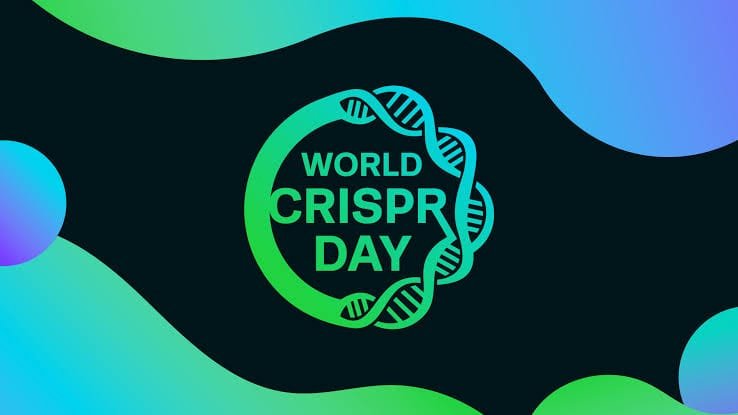World CRISPR Day – October 20, 2022, history, significance,
We celebrate World CRISPR Day on October 20 every year. It is a day to discuss the technological implications and practical application of the technology that is revolutionizing the treatment of genetic conditions.
CRISPR, short for Clustered Regularly Interspaced Short Palindromic Repeat, is a technology that edits genes by finding specific bits of DNA inside a cell. Once the DNA is identified, it proceeds to alter a piece of it or to turn genes on or off. The holiday started in 2020 when the leaders in genome engineering were brought under one virtual roof.
HISTORY OF WORLD CRISPR DAY

George Church, Jennifer Doudna, Emmanuelle Charpentier, and Feng Zhang, harnessed the power of CRISPR-Cas9 to alter the targeted regions of genomes, a technology that has the potential to revolutionize gene editing and was dubbed the greatest scientific breakthrough of the year 2015. For their work, Jennifer Doudna and Emmanuelle Charpentier were awarded the Nobel Prize for the year 2020, but CRISPR dates back a few years.
Dr. Yoshizumi and his team of Japanese scientists first identified CRISPRs in E. coli in 1987. They accidentally cloned a weird series of repeated sequences scattered among spacer sequences while analyzing a gene, but the monumental functions of this DNA sequence data remained unknown due to a lack of data.
In 1993, researchers led by J.D. Van Embden in the Netherlands were able to shed some more light on the data. Further breakthroughs came in 2000 when a team discovered the adaptive immunity of CRISPRs. CRISPR-Cas systems can function as a defense unit to stop repeated infections by the same virus.
Further research continued, and CRISPR became a hot topic in the scientific world. The application is very broad and could change the way we see microbiology. Countries such as China have even attempted to produce results in human tests, but these attempts faced backlash from the international scientific community for ethical reasons. CRISPR is still in a premature stage and is not yet ready for full-scale human trials. Technology can benefit the future generation in ways we cannot yet predict.
WORLD CRISPR DAY TIMELINE
1987
The First Discovery
Dr. Yoshizumi and his team discover CRISPRs in E. coli.
1993
CRISPR in Mycobacterium Tuberculosis
J.D. Van Embden from the Netherlands discovers CRISPR in ‘mycobacterium tuberculosis.’
2012
The Genome Editing Tool
George Church, Jennifer Doudna, Emmanuelle Charpentier, and Feng Zhang, discover CRISPR-Cas9 as a genome-editing tool.
2015
The Scientific Breakthrough of the Year
The scientific community names CRISPR as the breakthrough of the year.
HOW TO OBSERVE WORLD CRISPR DAY
Distribute scientific journals
CRISPR is complex, not everyone can understand the science. Prepare notes in layman’s terms about it, or find some scientific journals to share.
Watch the symposium
Make the time to watch the symposium in which the scientific community explains CRISPR. The world’s leading authorities in genome engineering will participate.
Share the news
Spread the latest news about CRISPR. New technological breakthroughs, studies, and papers are being updated daily.
FIVE INTRIGUING FACTS ABOUT CRISPR
Cell and gene therapies
CRISPR has the potential to cure a range of genetic diseases, including neurodegenerative diseases, blood disorders, cancer, and ocular disorders.
Therapeutics and diagnostics
In the fight against coronavirus, CRISPR was used as a therapeutic and diagnostic tool.
Nobel Prize 2020
The 2020 Nobel Prize for Chemistry went to Jennifer Doudna and Emmanuelle Charpentier for their work on CRISPR-Cas9.
First CRISPR-based treatment
In the U.S., Victoria Gray was the first to receive a CRISPR-based treatment for sickle cell disease.
Pigs in the frontrow
Scientists use pigs to experiment with genome editing.
WHY WORLD CRISPR DAY IS IMPORTANT
A breakthrough in science
CRISPR represents a breakthrough in the field of science. Its applications are very broad, and the science world is just getting started.
Cure for genetic conditions
Many people in the world are fighting genetic conditions. CRISPR is a beacon of hope for them.
Future super generation
The application of gene engineering is vast. Through it, we may see a new generation that’s immune to any disease.
Sandeep Raiza — Content Writer, Website Designer, SEO Strategist, and WordPress Expert AI specialist delivering impactful digital solutions that drive business growth.Combining creative storytelling with technical expertise.




